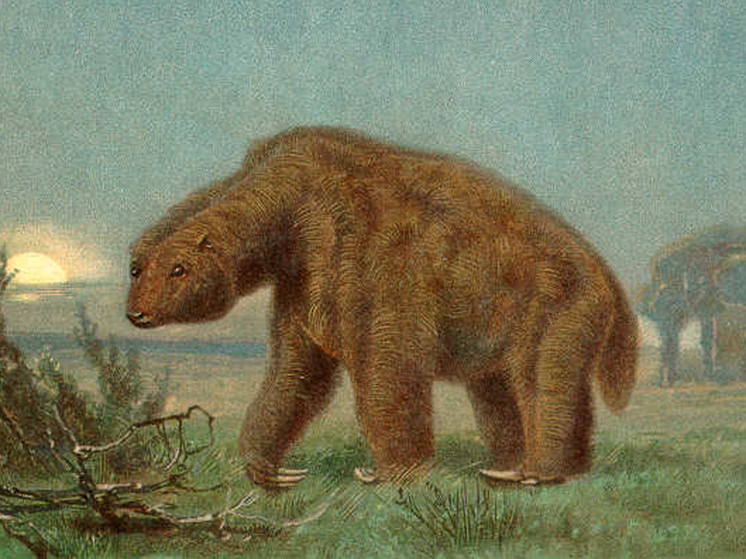Giant sloths in Brazil left their traces in the form of a pipe in the rock under a farmer's house
In Brazil, research continues on a prehistoric tunnel created by a giant sloth that lived in the country for more than 10 thousand years back. A farmer accidentally made a paleontological discovery when his tractor sank into the ground in 2009. Since then, archaeologists have been trying to unravel the mysteries of the tunnel in the Amazon region.
 < p>Scientists discovered a tunnel 2 by 2 meters and about 15 meters long with the help of a farmer whose tractor sank in his field. This discovery was made back in 2009. But scientists continue to deal with the mysterious discovery in paleontology, one of the British media reports. Deep claw marks were found on the walls of the tunnel, indicating that its former occupant was not human.
< p>Scientists discovered a tunnel 2 by 2 meters and about 15 meters long with the help of a farmer whose tractor sank in his field. This discovery was made back in 2009. But scientists continue to deal with the mysterious discovery in paleontology, one of the British media reports. Deep claw marks were found on the walls of the tunnel, indicating that its former occupant was not human.
The farmer, it turned out, had discovered a prehistoric tunnel dug into the rock, which, according to geologist Luis Carlos Weinschutz, was “the work of paws.” a giant ground sloth (or alternatively a giant armadillo), who lived at least 10 thousand years ago in Brazil.
These giant ground sloths, described in one article as “elephant-sized hamsters,” were a far cry from the leisurely, tree-dwelling sloths of today. They grew up to 4 meters in length and walked on all fours, although research suggests that some could stand and walk on two legs. Nearly 100 different species of sloths roamed the Americas between 15 million and 10,000 years ago, along with giant car-sized armadillos that also dug long tunnels into the rocks of modern-day Brazil.
“We analyzed the bones of animals that lived in this region over the past two million years. Animals such as horses, saber-toothed tigers, and elephants were not dug. We had to look for animals that have claws, then we are left with only two options: giant sloths and giant armadillos,” — explained the theory of who created the tunnels, geologist Heinrich Theodor Frank.
In 2015, the first report was released on the discovery of a 100-meter-long tunnel dug by giant sloths, which was found in the Amazon rainforest. In all the found “houses” The ancient giants had characteristic marks of long claws crisscrossing the walls. Most Paleozoic mounds are now filled with faunal fossils, although some remain completely or partially transparent. Researchers compare the tunnels to huge rabbit holes.
Geologist Frank notes: “When you enter any of these tunnels, you find an open book. You understand, you feel that this was not done by people, the scale is so amazing.”
The farmer's discovery in 2009 began a surge of interest in Paleozoic mounds after hundreds of them were discovered in southern and southeastern Brazil. Over the past 15 years, more than 1,500 such sites have been recorded in this region, cementing the region as having the highest concentration of Pleistocene megafauna in the world. No one knows exactly why there are so many of them in southern Brazil. Most of them are in the states of Santa Catarina and Rio Grande do Sul, but Minas Gerai. In June 2023, many of the largest Paleozoic burial sites were placed under official protection to protect them from human activity.
For some scientists, it remains unclear why so many mounds have been found throughout South America and not a single one in North America. Geologist Heinrich Frank notes that this is something for which there is no logical explanation, because megafauna roamed throughout the continent. “We must have tunnels in other places!”, — he added.
Experts explain this phenomenon by saying that Brazil has simply become a center of paleontological research. Others disagree, pointing out that the problem is geographic evolution across the Americas, where during the time of the megafauna it was 10 degrees Celsius colder than it is now and much drier.
For years, locals and researchers believed the tunnels were built by past civilizations, and the claw marks were thought to be the work of a pickaxe. Some Paleozoic mounds contain rock art, such as Toca do Tatu, whose walls are engraved with a sun with radiating rays and groups of triangles representing mountains. It is impossible to find out their dating, because the pictures are carved and not drawn.
In the days of treasure hunters, there were legends that the tunnels contained hidden riches left there by the Jesuits. This led to the caves being searched.
«Treasure hunters — This is a horror for archaeology. They disturb the soil and turn it over so that what is newer becomes older, and what is older becomes fresher,” — archaeologist Oliveira comments to the British publication, adding that this complicates the study of fossils in search of additional clues that could tell more about these tunnels.
The results may shed light on why these animals dug such large tunnels. Most scientists assume that this was done for nursing the young or for hibernation. Experts suspect each tunnel was dug over centuries or even thousands of years, suggesting sloths and armadillos lived in social family groups. “Each generation did a little more, so after so many years they created one big cave,” — says geologist Heinrich Frank.
























































Свежие комментарии